In this post, I’ll teach you how to make ultra-creamy, 4-ingredient homemade ricotta in under 1 hour (including straining time). Follow my step-by-step recipe instructions and video. So fresh and creamy!
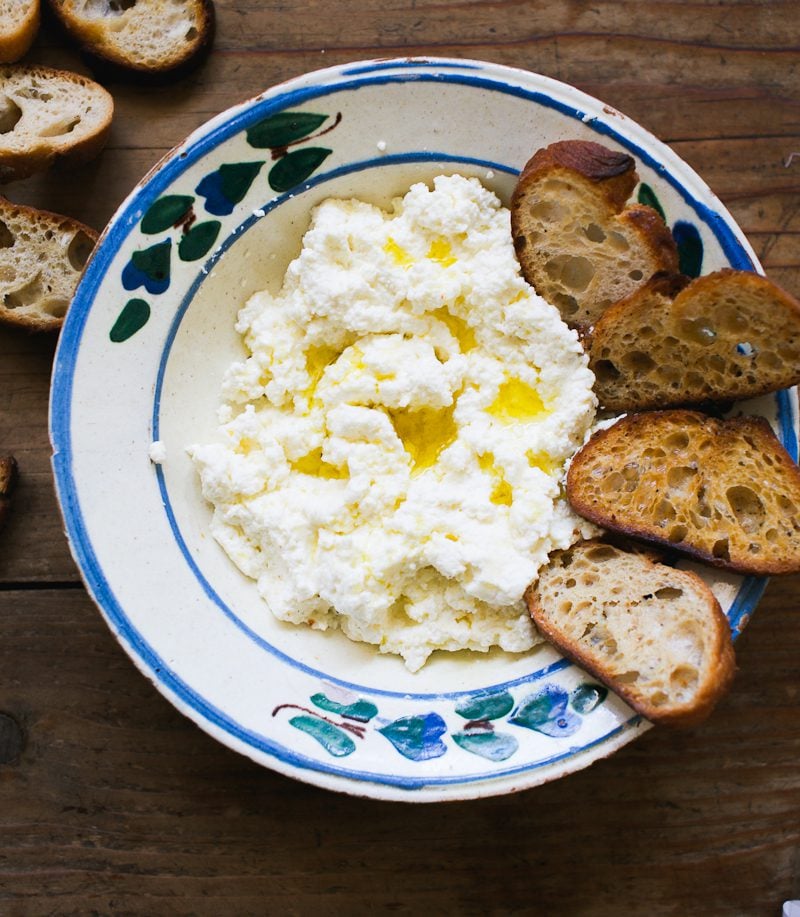
Ahh… Ricotta (rhee-koh-tah). Saying it out loud makes everything sound better, right? Whether it’s tossed with fresh homemade pasta and pomodoro sauce, folded into my one-bowl Italian almond cake or tucked into homemade ravioli, creamy ricotta will make anyone weak in the knees!
Now, I’m assuming you’re here because you want to make it yourself. You’re curious. Compared to store-bought, my homemade ricotta recipe is a completely different beast. It’s more creamy. Less grainy. Not as wet. The taste is light and delicate, and the whimsical fluffy texture is an unexpected conversation starter.
If this is your first time making ricotta, don’t worry about what you’re gonna do with it: think simple. Drizzle with olive oil, black pepper and serve warm with sourdough crostini as pictured above. Or, dollop on top of pasta for a marbled “cream sauce” effect. Get to know it. Understand it. Indulge in one of the most to-die-for recipes you’ll ever make at home.
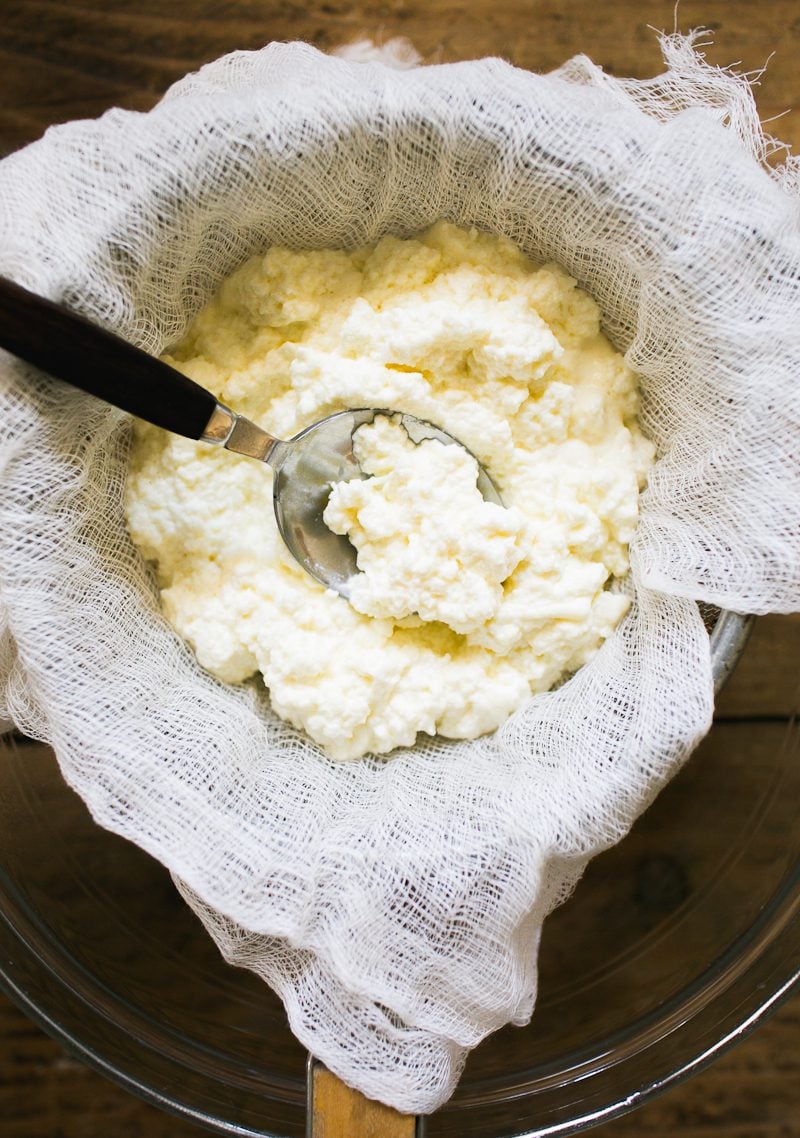
What You’ll Learn.
In this post, I’ll teach you how to make fresh homemade ricotta with 4 simple ingredients: milk, cream, lemon juice and salt. You do not need any fancy, expensive equipment to make fresh homemade ricotta. However, cheesecloth and a fine mesh strainer are required. The entire process takes less than 1 hour to complete, including straining time. You’ll end up with 1 heaping cup (265 g). You can also make it ahead.
But Please, Don’t Call It Cheese.
Did you know ricotta is technically not cheese? While flipping through American Sfoglino from which this recipe is loosely based, I learned ricotta does not undergo traditional fermentation. Therefore, it doesn’t count as cheese. Ricotta is actually the by-product of cheese production, which is what you’ll re-create in this post. Sounds super lengthy and technical, but it’s actually really easy to do. And fun.
Ricotta Origins: The Backstory
Ricotta was born out of necessity in Italy’s cucina povera (poor kitchen), by way of Sicily, birthing one of the most celebrated products in the world. Generally speaking: when cheese is made you get leftover whey, a cloudy, yellow-ish liquid. To avoid waste, because no one did that back in the day, clever cheese makers re-purposed the whey into something entirely new.
Making Ricotta.
Ricotta means “re-cooked” or cooked twice. First, milk is used to make cheese like Pecorino. Then, the leftover whey is heated again until curds float to the surface. When you strain these curds, you get fresh ricotta. This is the traditional method. For modern recipes (since most people do not have leftover whey to start with), lemon juice is added to the heated milk mixture to create ricotta curds instead.
Why This Recipe Works:
- I use a combination of whole milk and cream to emulate the richness of sheep’s milk, the traditional milk used to make ricotta in Sicily. My ratio is 3:1 (milk to cream).
- Allowing the mixture to rest for 10 minutes before straining ensures light, delicate and fluffy ricotta.
- This is a small batch recipe, which yields about 1 heaping cup (265 g). Ricotta doesn’t last long in the fridge, about 4 days, so only make what you need. This recipe can easily be doubled.
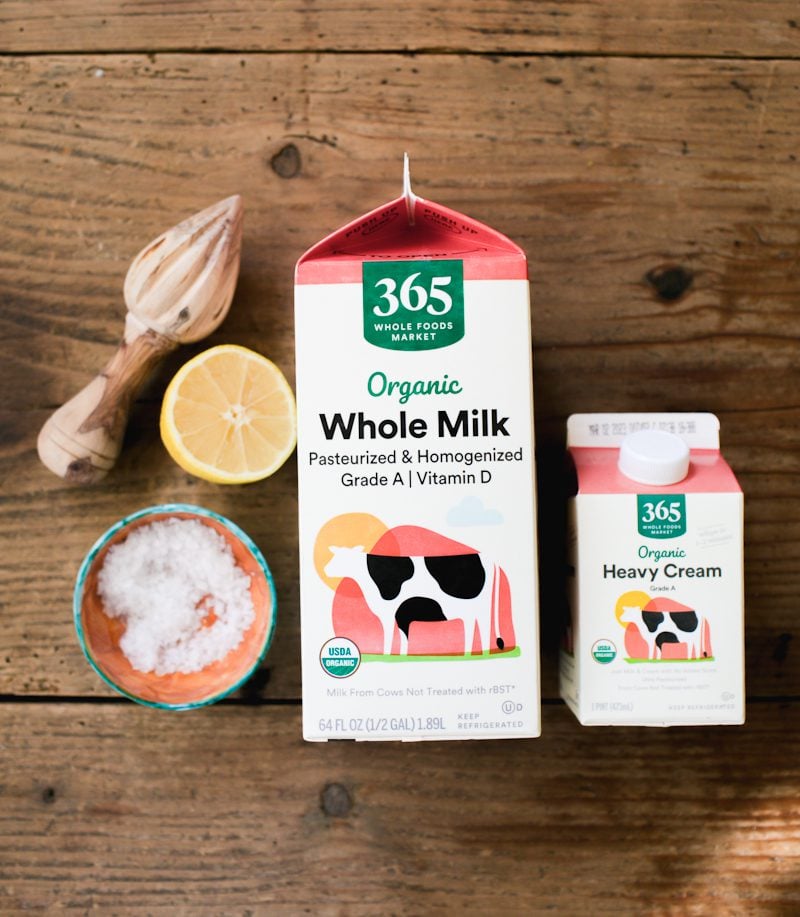
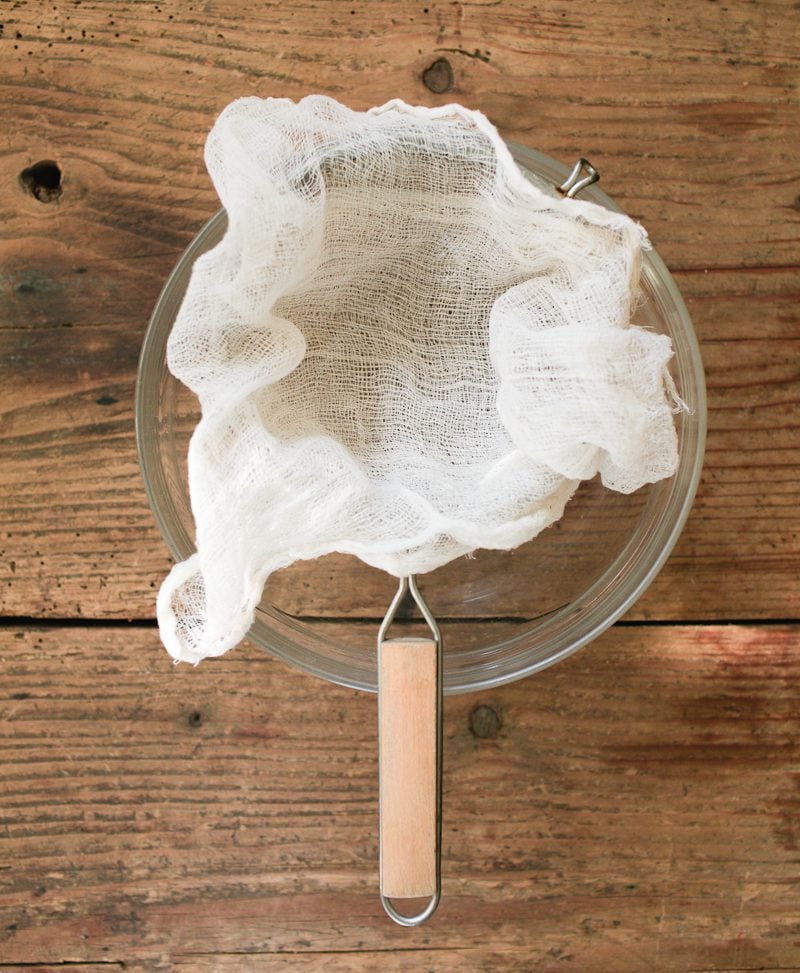
Homemade Ricotta Ingredients & Supplies (You Will Need):
Ingredients:
- Whole Milk (not ultra pasteurized!): I recommend whole cow’s milk for creamy flavor and texture. Alternatively, 2% or 1% milk can be used; but the final result will not be as creamy. Ultra pasteurized milk does not work for homemade ricotta. It won’t curdle properly. Look for good-quality pasteurized milk, either regular or organic. This recipe was successfully tested with Whole Foods 365 Organic Milk, Horizon Organic Milk and Trader Joe’s Organic Milk.
- Cream: Heavy cream or whipping cream can be used. Both work. Oddly enough, ultra-pasteurized cream can be used, which is a good thing because regular pasteurized cream is hard to find.
- Lemon Juice: This is your acidic ingredient needed to curdle the milk and cream mixture. It does not impart a tangy taste unless you add more than what’s indicated in the recipe. Substitute with white vinegar or red wine vinegar.
- Salt: I prefer just a pinch, about 1/4 teaspoon of fine sea salt to enhance the creamy, dairy flavor.
Supplies:
- 7-inch Fine mesh strainer
- Cheesecloth
- Heavy bottom pot or enameled cast iron braiser (as pictured below).
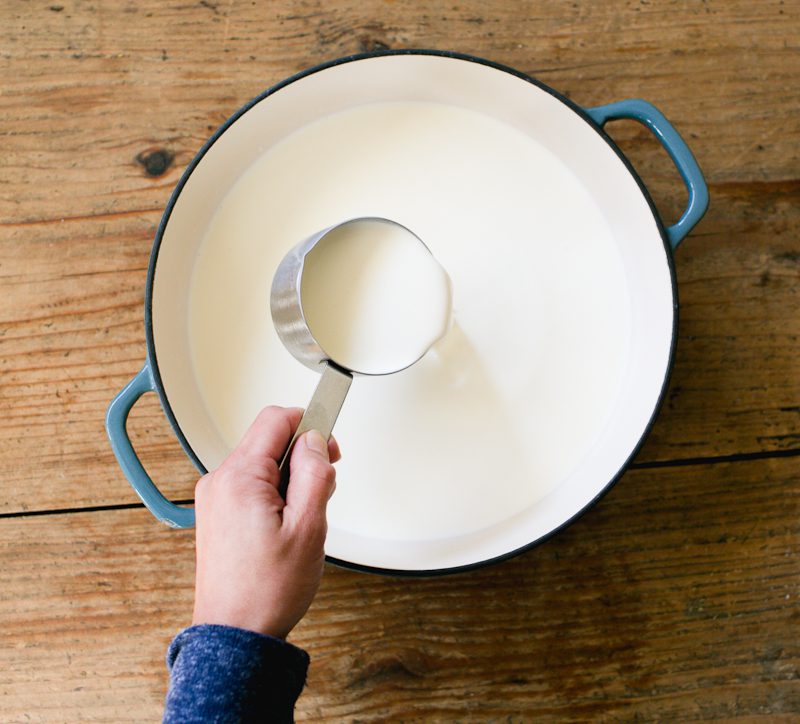
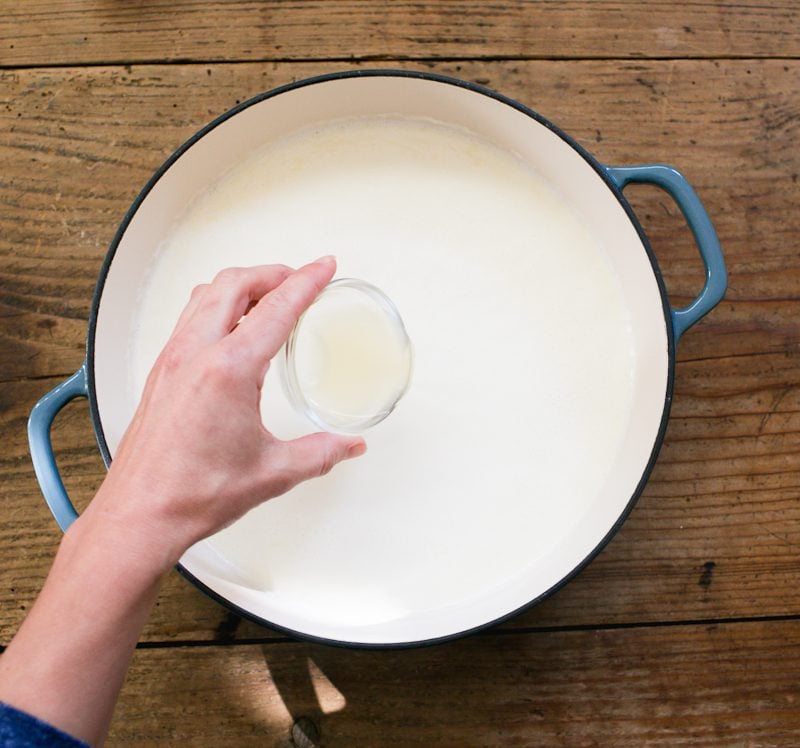
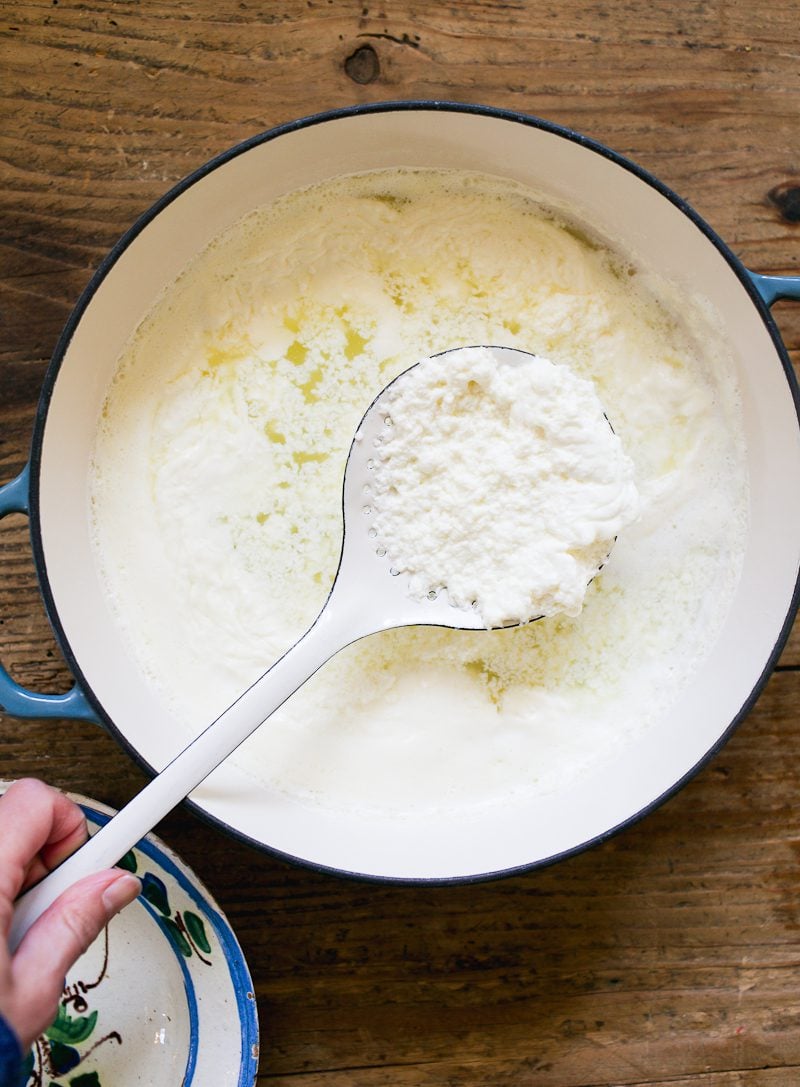
How To Make Fresh Homemade Ricotta: Step-By-Step Recipe
- In a heavy bottom pot, add the milk, cream and salt. Adjust the heat to medium-high.
- Bring the mixture to a rolling boil, approximately 200-206 F/ 93-97 C. Do not boil aggressively; the ricotta will be rubbery. Tip: while the mixture is heating up, use a wooden spoon to stir in a “figure 8” motion so nothing sticks to the bottom of the pot. Scorched milk = bitter ricotta. Once the mixture has come to a boil, the next steps below happen quickly and in succession. Do not lolly-gag around!
- In this order: add the lemon juice, stir twice, and turn off the heat. Do not stir; the mixture will start to curdle. Let it sit (untouched) on the warm turned off burner for 10 minutes. Small and large curds will float to the surface.
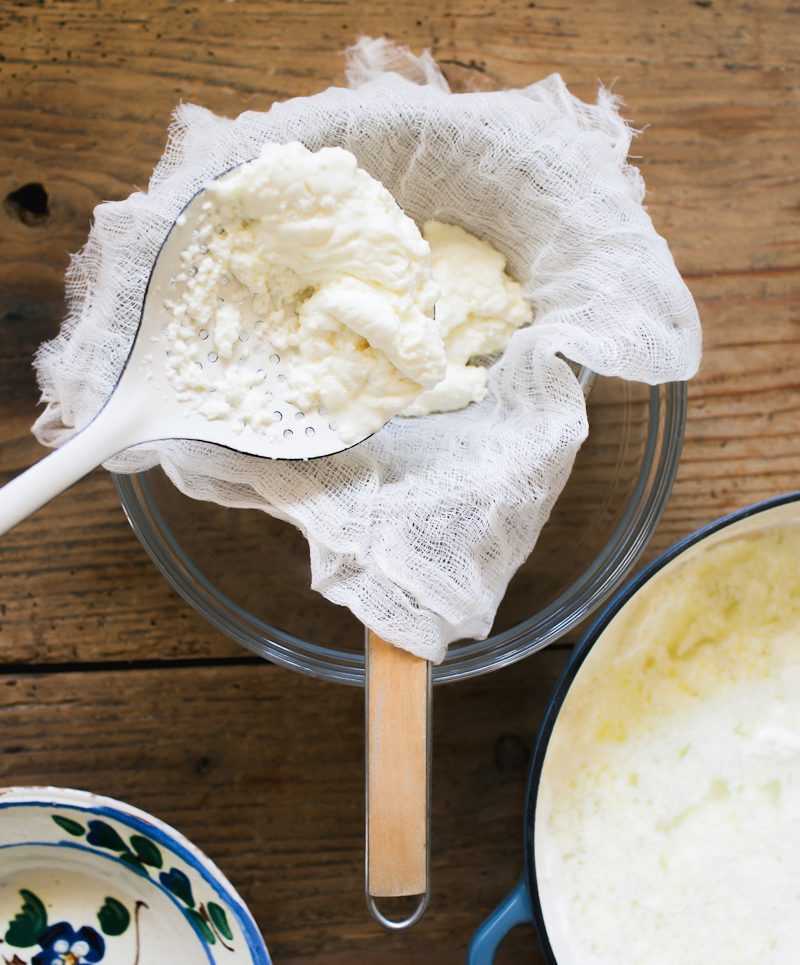
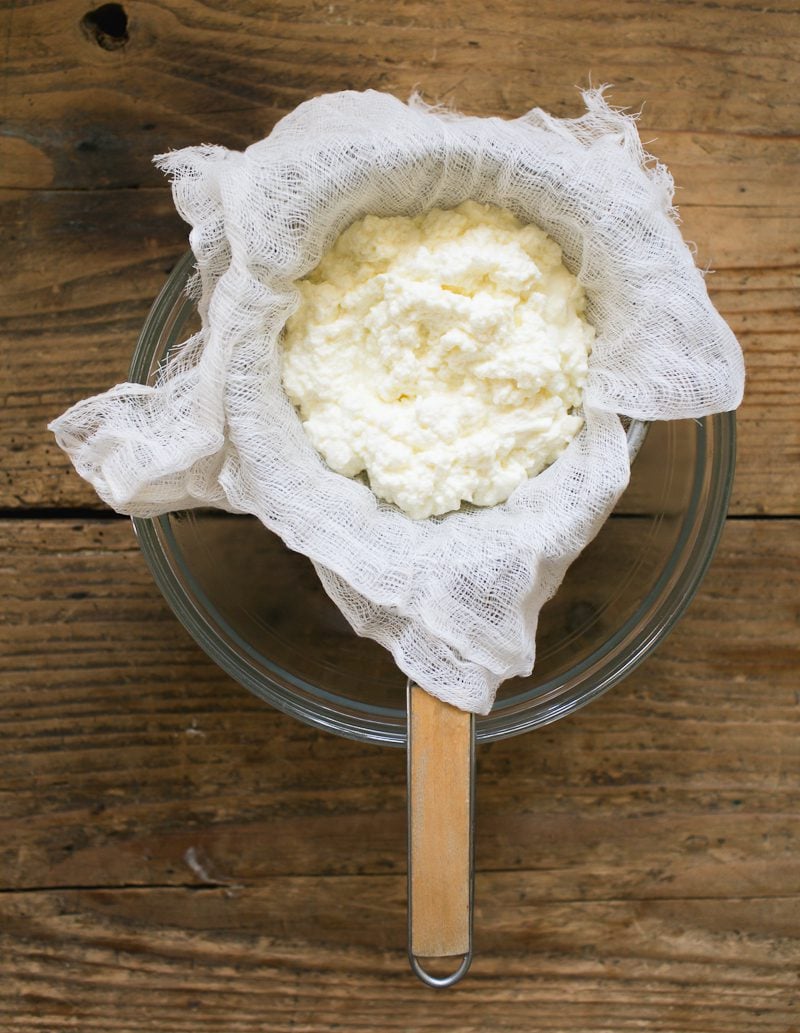
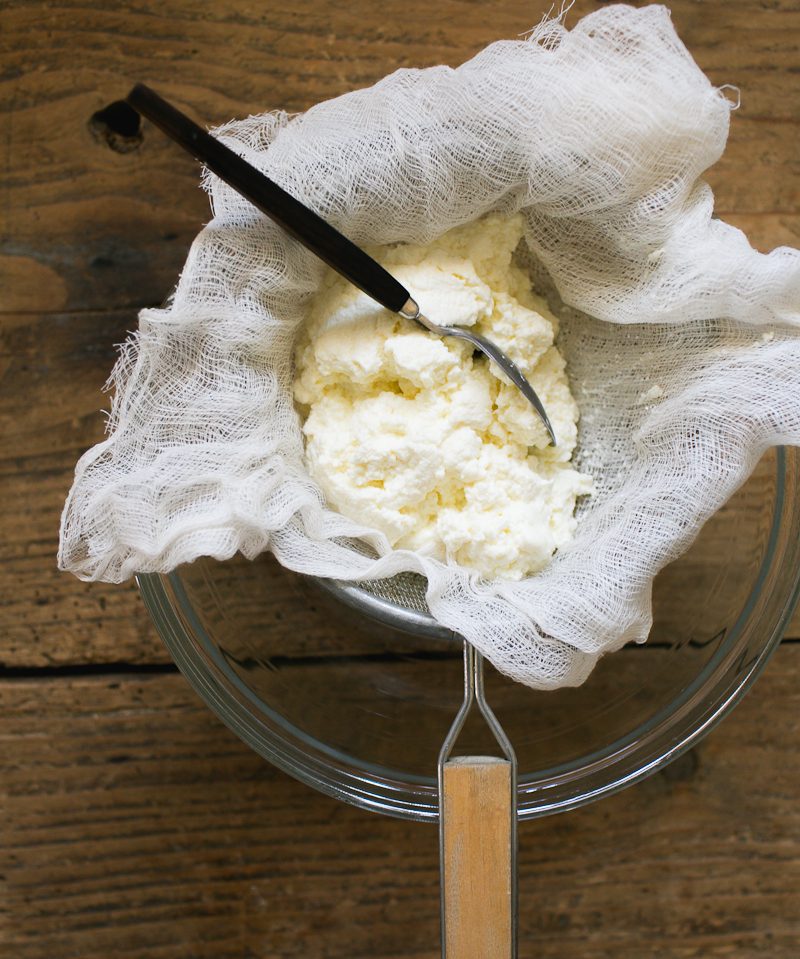
- With a slotted spoon, transfer the ricotta curds to a cheesecloth-lined strainer.
- Drain over a deep bowl at room temperature, about 10-15 minutes for light and fluffy ricotta. For drier ricotta, strain longer. The desired consistency is ultimately up to you.
- When finished, the ricotta will still be warm. Use right away, or transfer to an air-tight container and refrigerate until ready to use.
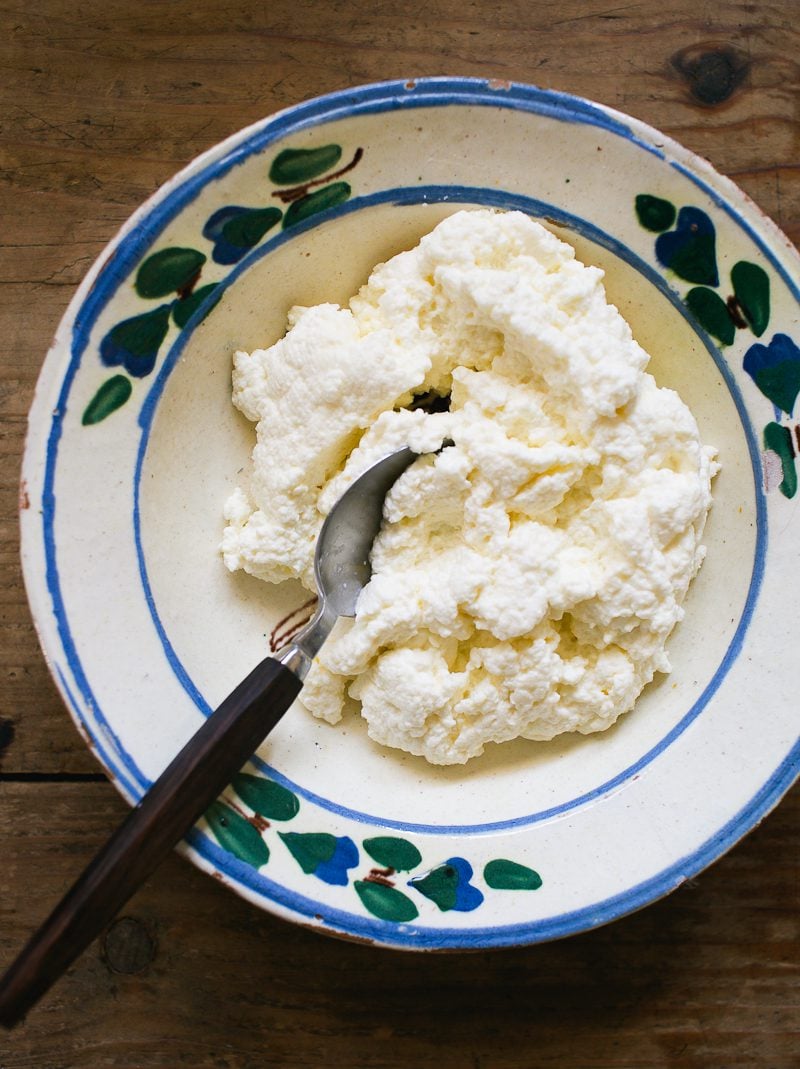
Homemade Ricotta Tips:
- Understand texture. When the ricotta is strained at room temperature, it will be light, fluffy and warm. When chilled in the refrigerator, it becomes more creamy, slightly dense and cold. Both textures and temperatures can be used for a wide variety of ricotta recipes and dishes.
- Use a thermometer (optional). Most ricotta recipes recommend heating the milk and cream to a specific temperature. Use a digital thermometer to double check. If you don’t have one, just look for visual clues: the mixture should come to a rolling boil, with frothy bubbles around the sides and in the center of the pot.
- Save your cheesecloth. Wash used cheesecloth in mild, soapy water and rinse clean. Drape over the back of a chair to air-dry.
- Don’t use ultra pasteurized milk! I mentioned this earlier, but I’m going to say it again just in case you missed it! Ultra pasteurized milk doesn’t not curdle properly for ricotta. Use regular pasteurized milk instead.
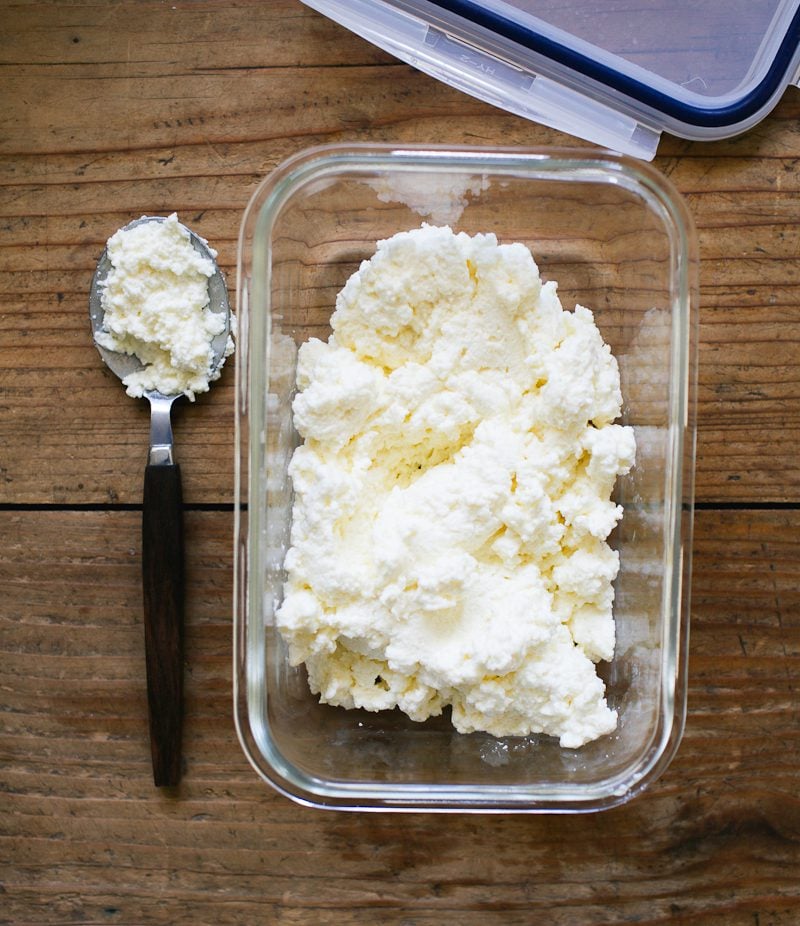
How To Store Fresh Homemade Ricotta
Portion homemade ricotta into an air-right container and store in the fridge, up to 4 days. I like glass containers. Pour off any residual liquid on the surface, if necessary, before using.
Can You Freeze Homemade Ricotta?
No. Because ricotta is made with mostly milk, when frozen, ice crystals will form changing the structure and texture of the ricotta. That’s why this is a small batch recipe; it’s doubtful you’ll have any leftover depending on what you’re using it for. No waste!
Can You Make Ricotta Ahead Of Time?
Yes. Ricotta can be made up to 4 days in advance. Compared to freshly made ricotta, the texture will be more firm due to extra chilling time in the refrigerator. Use the ricotta cold or bring to room temperature first.
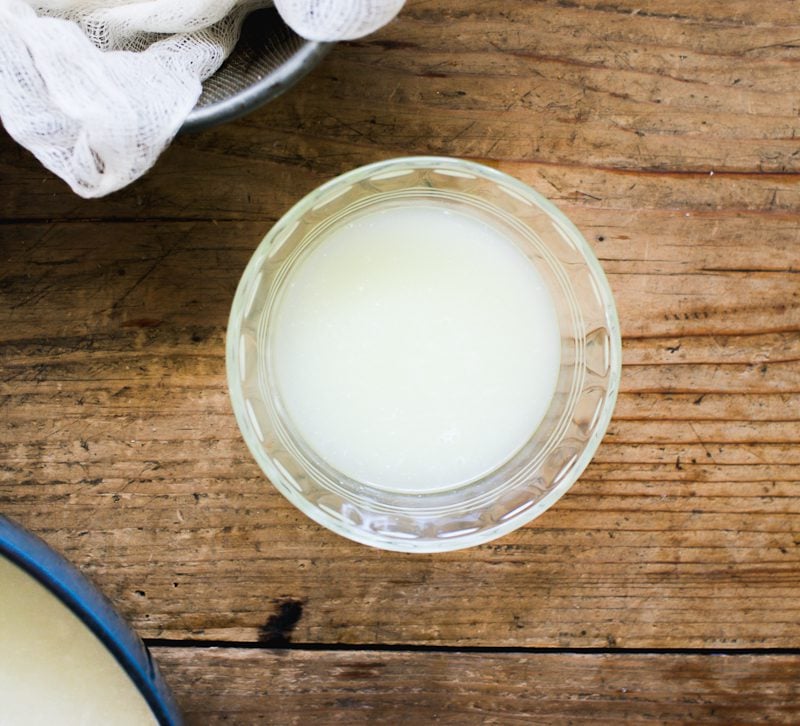
What To Do With Leftover Whey?
After straining the ricotta, you’ll get leftover whey at the bottom of the bowl. You can either toss it, or make something else. Taste it first. It’s a little tangy and salty, so I recommend adding whey to recipes where this flavor profile makes sense: sourdough bread, sourdough focaccia and/or sourdough pizza crust. Additionally, it can be used in smoothies and to ferment vegetables if that’s your thing! Whey will last for a few months in the fridge or freezer; however I like to freeze mine right away (I’ll forget about it otherwise).
More Ricotta Recipes To Try!
- Soft Italian Ricotta Cookies
- Ultra-Quick Lemon Ricotta Pasta With Spinach
- One-Bowl Italian Almond Ricotta Cake
- Beginner’s Guide To Fresh Homemade Ravioli
- Homemade Mushroom Ravioli
- Light & Fluffy Homemade Ricotta Gnocchi
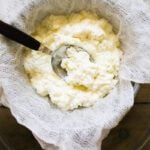
Ultra-Creamy Fresh Homemade Ricotta {+Video!}
- Prep Time: 25 minutes (resting + strain time)
- Cook Time: 10 minutes
- Total Time: 35 minutes
- Yield: 1 heaping cup (265 g)
- Category: Homemade Ricotta
- Method: Boil
- Cuisine: Italian
- Diet: Vegetarian
Description
This easy, ultra-creamy, 4-ingredient ricotta recipe is super simple to make. All you need is milk, cream, lemon juice and salt, plus cheesecloth and a fine mesh strainer. Ready in less than 1 hour, including straining time. This is a small batch recipe, about 1 cup, which is perfect for most recipes, like cookies and ravioli filling- no waste. Method adapted from American Sfoglino.
Ingredients
- 3 cups whole milk (DO NOT USE ultra pasteurized milk)
- 1 cup cream (ultra pasteurized is fine)
- 1/4 tsp fine sea salt
- 2 tbsp fresh lemon juice, strained
Notes, Tips & Substitutions:
- Read the entire recipe a few times before starting. Some of the steps happen quickly!
- Do not use ultra-pasteurized milk; it won’t curdle properly.
- White or red vinegar can be used instead of lemon juice.
- If doubling the recipe, you won’t be able to drain the mixture in a 7 or 8 inch strainer; it won’t fit. Work in batches and adjust your strain time accordingly. Or use 2 strainers if you have them.
Instructions
- Line a fine mesh strainer with a double layer of cheesecloth. Set over a large, deep bowl.
- In a heavy bottom pot, add the milk, cream and salt. Adjust the heat to medium-high.
- Bring the mixture to a rolling boil, approximately 200-206 F/ 93-97 C. Do not boil aggressively; the ricotta will be rubbery. Tip: stir the mixture frequently as it begins to heat up. Do this with a wooden spoon in a “figure 8” motion so nothing sticks to the bottom of the pot. Scorched milk = bitter ricotta. The mixture is heated correctly when you see frothy bubbles along the sides and larger bubbles in the center. Use a digital thermometer to check (optional). Once the mixture has come to a boil, the next steps happen quickly and in succession. Do not lolly-gag around!
- In this order: immediately add the lemon juice. Stir only one or two times to distribute. Turn off the heat. Do not stir; the mixture will start to curdle. Let it sit (untouched) on the warm turned off burner for 10 minutes. Small and large curds will float to the surface.
- Using a slotted spoon, transfer the curds into your lined strainer to drain.
- Strain at room temperature, about 10-15 minutes for light and fluffy ricotta. If you want a drier texture, strain for longer. The ricotta will get more firm when stored in the refrigerator; take this in account when estimating your straining time.
- Portion the ricotta into an air-tight container. Store in the fridge, for up to 4 days. Enjoy!
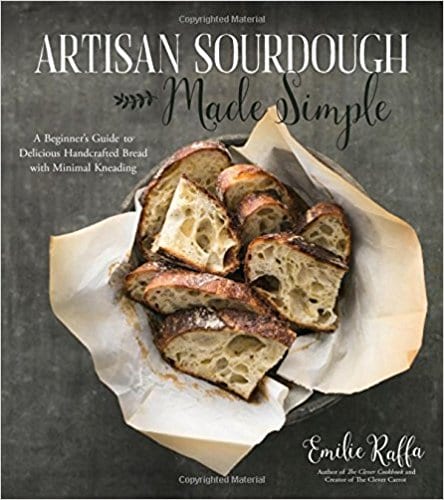

Comments
Jess Haygood says
Just made a batch because I am making it for a spasangna tonight. (Left over skeddi with meat sauce formed into lasagna). This recipe is excellent, and it turned out pretty dang good for my 1st go. Didn’t have a wooden spoon handy, oh well. I have a glass top stove so I had to intermittently remove from burner to prevent scorching. You mentioned a firmer product when straining longer, so I went for a 20 minute strain. THANK YOU!!
A. Cassidy says
It is so simple and so delicious. I love that this recipe only have a few ingredients and the ricotta turned out so creamy. I’ll never buy ricotta cheese at the store anymore. Thanks!
Molly Milner says
3rd time making this recipe….LOVE IT!!!!!
Anne Wilson says
Can you make this with lactose free ingredients
Jenn says
Can you make this with lactose free milk? Please say yes, lol
LT says
Mouth watering! I am so glad I came across this recipe! I tripled the recipe and used lemon juice. I drained it for only 5 minutes because I like mine very smooth. It came out beautifully and super creamy!
Ines says
I made this!! I’ve been wanting to try a fresh homemade ricotta recipe for months and finally found yours and it looked easy enough.
I will make this everytime I need ricotta from now on, it’s so so delicious! And really not that difficult, but like you mentioned in the recipe it’s better to read it all before starting! I made ricotta and egg yolk ravioli with it, and also had it with some toasted bread and I loved it as it’s so creamy and fluffy. Thank you so so much.
Cyndi says
Can’t wait to get the ingredients and try my hand at making my own Riccotta!
Kathy Stahl says
How is this different from dry cottage cheese?
Eliza says
I used this recipe while teaching in Hawaii, they only have access to ultra pasteurized milk and cream. It came out beautifully! We even quadrupled the batch.
I will continue to use this recipe in my “cheese” making classes. Thank you!
Susan says
Hello Emilie, This looks wonderful and I can’t wait to try. If I use it for lasagne, would you mix an egg & parmesan cheese into it, as most recipes recommend?
Maryam says
in the UK, should i just use double cream or single?
Emilie Raffa says
Hi there! I would use single cream. Alternatively, use all full fat milk (it will be slightly less decadent, but still wonderful).
Christi says
This looks delicious. Can you use whole raw milk for the recipe?
Emilie Raffa says
Hi Christi! I haven’t tested it myself, but I don’t see why not? Sounds delicious. It might impart a very slight tangy flavor but it all depends, especially if using it warm or cold.
Vera Kay says
Thank you Emilie for your reply have just got a batch of your bagels out of the oven. Love your recipes working through them !!
Emilie Raffa says
Hi Vera! Thank you very much! So kind of you to say!
Lourdes Monterroso says
Made this recipe, but the mixture did not came as curdy as you photos, mine was much more liquid. Any suggestions?
Emilie Raffa says
Hi Lourdes! Yes: make sure the milk and cream mixture is at least 200 F. If it’s not hot enough, oftentimes notable curds don’t form. Also, right after you add the lemon juice, make sure to stir it briefly (only 1 or 2 times!) to evenly distribute the acid. If you don’t do this, you’ll get more curds in the center and liquid around the edges. Now, if you’re writing this comment real time, and you still have the warm curds/liquid in the pot, gently stir in 1 tablespoon of lemon juice to salvage it. You should see more curdles form. The final ricotta will taste more lemony when warm, but the flavor will mellow out when chilled.
Yvonne says
I made this today and it was simple and the flavor is everything you said it would be. I had some sourdough rolls on hand and so we had it on them with chili. I sprinkled some TJ’s Everyday Seasoning on it. So very yummy. There’s only one problem….I’m pretty sure it is addictive! And I’ve never cared for ricotta unless mixed in a recipe.
Pwvon says
When you use whey in sourdough, do you use it in the starter?
Emilie Raffa says
Hi there! I actually use the whey in the dough. For example, I might replace part of the water with whey instead, depending on the recipe. Now technically, it is possible to use whey in your sourdough starter if you want. However, the leftover whey from this recipe contains lemon juice (acid) and salt. This will change the ph levels of your sourdough starter which effects flavor, taste, and texture. Something to play around with.
Vera Kay says
Hi Emilie
Loved the video and made the Ricotta tastes way better than the shop bought one, was I supposed to stir in the lemon juice ?
Thanks for your recipes have made a few now especially your Sourdough Bagels.
Warm regards
Vera Kay
Australia
Emilie Raffa says
Thank you Vera! I’m so glad you made it (and the bagels!). Totally different than store-bought, right? For the lemon juice, yes, give it a brief stir- only one or two times- to evenly distribute. I updated the recipe to clarify :)
CMR says
Loved the video Emilie and the simplicity to this recipe. Watched it twice! I really look forward to your emails on Sunday! I appreciate the links for the recipe. I need to buy the cheesecloth and you make the steps so easy!
So talented!
Emilie Raffa says
Ahhh… this made me smile (like, really big lol). Thank you so much!